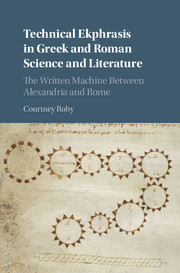Description
Technical Ekphrasis in Greek and Roman Science and Literature
The Written Machine between Alexandria and Rome
Author: Roby Courtney
This book analyzes the rhetorical and visual strategies used in technical texts and non-technical literature to describe technological artifacts.
Language: English
Subject for Technical Ekphrasis in Greek and Roman Science and...:
Approximative price 119.00 €
In Print (Delivery period: 14 days).
Add to cart
Publication date: 02-2016
334 p. · 16x23.5 cm · Hardback
334 p. · 16x23.5 cm · Hardback
Description
/li>Contents
/li>Biography
/li>
Ekphrasis is familiar as a rhetorical tool for inducing enargeia, the vivid sense that a reader or listener is actually in the presence of the objects described. This book focuses on the ekphrastic techniques used in ancient Greek and Roman literature to describe technological artifacts. Since the literary discourse on technology extended beyond technical texts, this book explores 'technical ekphrasis' in a wide range of genres, including history, poetry, and philosophy as well as mechanical, scientific, and mathematical works. Technical authors like Philo of Byzantium, Vitruvius, Hero of Alexandria, and Claudius Ptolemy are put into dialogue with close contemporaries in other genres, like Diodorus Siculus, Cicero, Ovid, and Aelius Theon. The treatment of 'technical ekphrasis' here covers the techniques of description, the interaction of verbal and visual elements, the role of instructions, and the balance between describing the artifact's material qualities and the other bodies of knowledge it evokes.
Introduction: the written machine; 1. Genres: texts and artifacts; 2. Cultural contexts; 3. The ekphrastic complex; 4. Diagram and artifact; 5. Description and instruction; 6. Knowledge and artifact; 7. Conclusion: the limits of description.
Courtney Roby is Assistant Professor in the Department of Classics at Cornell University. Her research interests include the literary techniques used in scientific and technical texts from the ancient Mediterranean, the interaction of verbal and visual elements in those texts, and the role of the imagination in ancient scientific discourse.
© 2024 LAVOISIER S.A.S.

